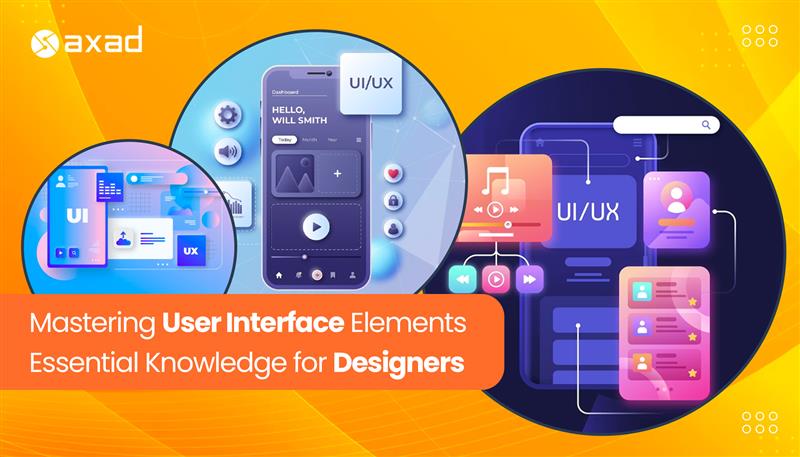Mastering User Interface Elements: Essential Knowledge for Designers
| September 9, 2023
Introduction:
In the dynamic world of design, creating a seamless and intuitive user experience is paramount. User interface (UI) elements play a pivotal role in shaping the way users interact with digital products. From websites to applications, mastering these elements is key to delivering a visually pleasing and user-friendly interface. In this AXAD comprehensive guide, we’ll explore the fundamental UI UX design elements every designer should know to create exceptional UI UX design services.
Buttons: Navigational Necessities
Buttons are the workhorses of UI UX Design. They guide users to perform specific actions, such as submitting forms, navigating to different pages, or making selections. Well-designed buttons are visually distinct, easily recognizable, and responsive to user interactions.
- Forms: Seamless Data Entry
Forms serve as gateways for user input. Whether it’s capturing user information or enabling search functionality, forms should be intuitive and straightforward. Group related fields, provide clear labels, and offer real-time feedback to enhance the user’s understanding and streamline the data entry process.
- Navigation Menus: Guiding the Journey
Navigation menus are the roadmaps to a digital product’s various sections. They should be easily accessible, organised logically, and responsive to different devices. From dropdowns to sticky headers, navigation menus ensure users can traverse a product’s content effortlessly.
- Icons: Visual Language
Icons are a universal visual language that transcends barriers. They convey meaning quickly and succinctly, enhancing user understanding. Effective iconography simplifies complex actions, making them a powerful tool for enhancing UI/UX design.
- Typography: Clarity and Consistency
Typography is more than just choosing fonts; it’s about creating hierarchy, readability, and visual appeal. Consistent typography across a product helps establish brand identity while ensuring users can easily consume content.
- Cards: Organised Information
Cards are versatile UI elements that present information in bite-sized chunks. They facilitate content organisation and adapt well to various devices, making them ideal for responsive UI/UX design services. Cards enable designers to showcase images, text, and interactive elements in a structured manner.
- Modals: Focused Interaction
Modals, also known as pop-ups, grab users’ attention by overlaying content on the main interface. They’re great for presenting additional information, capturing user input, or confirming actions. Well-designed modals should be easily dismissible and not disrupt the user’s flow.
- Progress Indicators: Transparent Processes
Progress indicators keep users informed about ongoing processes, ensuring they’re not left wondering about the system’s status. From loading animations to step-by-step progress bars, these elements enhance transparency and reduce user frustration.
- Images and Visual Content: Engaging Experiences
Images, illustrations, and other visual content add depth and personality to a UI. They can evoke emotions, provide context, and enhance engagement. However, optimising images for different devices is crucial to maintain a smooth user experience.
- Feedback Elements: Enhancing Interaction
Feedback elements, such as tooltips, notifications, and error messages, enhance user interaction. They provide guidance, inform users about successful actions, and offer clarity when things go wrong. Well-designed feedback elements ensure users are never left in the dark.
- Sliders and Carousels: Dynamic Displays
Sliders and carousels showcase multiple pieces of content in a limited space. While they can grab attention, they should be used judiciously to avoid overwhelming users. Clear navigation and compelling content are key to their success.
- Color Scheme: Aesthetic Harmony
A well-chosen color scheme can evoke emotions, establish brand identity, and improve user experience. Understanding color theory, contrast, and accessibility ensures that your ui ux design choices are both visually appealing and inclusive.
Final Thought
As a designer, your proficiency in UI elements is instrumental in shaping exceptional user experiences. By mastering these fundamental elements, you’ll create interfaces that are not only visually appealing but also intuitive, efficient, and engaging. Remember, the essence of effective UI UX design lies in understanding the user’s needs, maintaining consistency, and continuously refining your skills to stay ahead in the ever-evolving world of design. With these essential UI UX design services elements in your toolkit, you’re poised to craft interfaces that delight users and elevate your design prowess to new heights.
